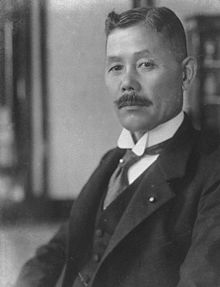Wakatsuki Reijirō
Wakatsuki Reijirō ( Japanese 若 槻 禮 次郎 ; born March 21, 1866 in Matsue , Japan , † November 20, 1949 in Tokyo ) was a Japanese politician and the 25th and 28th Prime Minister of Japan . In 1931 he was made a baron . - He was often called Usotsuki Reijirō by political opponents , which translated means Reijirō the liar .
Early life
Wakatsuki was born in Matsue in the then Izumo province into the Okumura samurai family, which served the Matsudaira clan. He later married a daughter from the Wakatsuki family and was adopted by them and made heir as they had no male descendants themselves. In 1892 he went to Tokyo University and studied law .
Political career
After graduating, he worked in the Ministry of Finance , first as Director of the Tax Office and later as Deputy Minister ( State Secretary ). On August 24, 1911, he was admitted to the Japanese mansion , of which he was a member until its dissolution in 1947. In the third cabinet of Katsura Taro from December 21, 1912 to February 20, 1913 and in the second cabinet of Ōkuma Shigenobu from April 16, 1914 to August 10, 1915, he served as Minister of Finance . During this time he became a leading member of the Rikken Dōshikai and in 1914 their successor party, the Kenseikai .
On June 11, 1924 he became Minister of the Interior in the cabinet of Katō Takaaki, where he played a leading role in the creation of some important laws.
When Prime Minister Katō died unexpectedly in office on January 28, 1926, Wakatsuki was appointed first acting Prime Minister and then Prime Minister on January 30 ( Wakatsuki I Cabinet ) and remained so until April 20, 1927, when the effects of the Shōwa- Financial crisis forced to resign. At the same time he held the office of Interior Minister again until June 3, 1926.
After attending the London Naval Conference as Plenipotentiary , he advocated rapid ratification and implementation of the disarmament provisions of the treaty passed there in Japan, which made him many enemies in the ranks of the military and ultra-nationalists.
When Prime Minister Hamaguchi Osachi was forced to resign after an assassination attempt because of his injuries, Wakatsuki was the new leader of the Rikken Minseitō and took over the office of Prime Minister again, this time from April 14 to December 13, 1931. From September 10 In 1931, until the replacement of his cabinet , he was also Colonial Minister .
In his second term failed Wakatsuki that to have more and more government control withdrawing military in his place, making it in Manchuria to Mukden Incident and in consequence of the unauthorized occupation of Manchuria by the Japanese army came. These events forced him to resign in December. Even after his withdrawal, Wakatsuki openly denounced the power of the military and warned of war with the United States . After the beginning of the Pacific War , he pleaded for a peace agreement as soon as possible.
literature
- Herbert B. Bix: Hirohito and the Making of Modern Japan. Harper Perennial, 2001, ISBN 0-06-093130-2 .
- Piers Brendon: The Dark Valley: A Panorama of the 1930s. Random House, 2002, ISBN 0-375-70808-1 .
- Marius B. Jansen: The Making of Modern Japan. Harvard University Press, 2002, ISBN 0-674-00991-6 .
- John Tolland: The Rising Sun: The Decline and Fall of the Japanese Empire, 1936-1945. Quadrangle Books, 2003, ISBN 0-8129-6858-1 .
| predecessor | Office | successor |
|---|---|---|
| Yamamoto Tatsuo |
Minister of Finance 1912–1913 |
Takahashi Korekiyo |
| Takahashi Korekiyo | Minister of Finance 1914–1915 |
Taketomi Tomitoshi |
| Mizuno Rentarō |
Minister of the Interior 1924–1926 |
Hamaguchi Osachi |
| Hara Jūjirō |
Colonial Minister 1931 |
Hata Toyosuke |
| personal data | |
|---|---|
| SURNAME | Wakatsuki, Reijirō |
| ALTERNATIVE NAMES | 若 槻 禮 次郎 (Japanese) |
| BRIEF DESCRIPTION | Japanese Minister and Prime Minister |
| DATE OF BIRTH | March 21, 1866 |
| PLACE OF BIRTH | Matsue |
| DATE OF DEATH | November 20, 1949 |
| Place of death | Tokyo |
